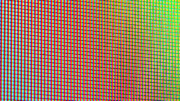If you’ve recently been watching the reboot of Frasier on Paramount+, you’ve probably been tempted to watch a few of the older episodes as well. If you watch them on broadcast TV, they’re really blurry and ugly-looking. But, if you stream them on Paramount+, they’re super-sharp. Why is this? And how do shows like Friends, Seinfeld, and even Star Trek: The Original Series look so good when they were designed for standard-definition TVs?
It’s all about how it was shot originally
When you see a show that looks crystal clear in high definition even though it’s over 20 years old, there’s a simple reason. Shows that were shot on film initially will translate to high definition very well. Shows that were shot on video tape will not. Let’s take a deep dive into the different eras of TV production.
In the beginning: it was all film
Commercial video tape was very rare until the 1970s. So, every single TV show was shot on film. Live shows were transferred to film by (I am not making this up) pointing a film camera at a specially designed television screen called a telecine. Even early shows like I Love Lucy were shot on film, and the quality level was better than TVs were capable of showing at the time. However, with HDTVs, the original film can be scanned and it will look amazing, as you can see from restorations of shows like Star Trek: The Original Series and The Love Boat.
The 1970s: analog video tape
Video tape was a revolution in making television shows. The cost for producing shows on video tape could be as little as 1/10th the price of producing them on film. Video tape can be reused if you don’t need the raw footage, and it’s cheaper than film to start with. It also doesn’t need costly chemical developing.
As commercial-grade video tape became available in the early 1970s, it ushered in a wave of low-cost production. A lot of shows were shot and produced on video tape in standard definition. The quality was incredibly bad by today’s standards, but people didn’t care.
It’s recently become possible to use AI to improve the quality of shows shot on video tape. Take a look at this remaster of a typical 1980s game show. You wouldn’t mistake it for true 4K but it’s very watchable:
The 1980s and 1990s: Prestige television on film
Producing TV shows on film never went away. As video tape became the norm for comedies and soap operas, it got a reputation for poor quality. Not poor picture quality. I mean that the shows themselves were thought of as being worse because they weren’t made on film. This led to prestige dramas like Dynasty, L.A. Law, and others staying with film. The “film look” told viewers they were getting top-notch programming.
Shows like this can easily be remastered into HD by scanning them. It’s a common process and as long as the original masters are in good shape, it takes very little time. Recently, Hulu released an HD remaster of Moonlighting which looks as good as anything made today, if you can forgive the big hair and shoulder pads.
The 1990s and 2000s: Digital video tape, film-to-video and “film-lit video”
In the 1990s, a new technology came into play: digital video tape. This gave quality about four times as good as traditional video tape while keeping the price low. This opened up three options which were not previously available:
Straight digital video
Shows recorded on digital video can be upsampled to near-HD quality. You’ll still notice a little blurriness compared to “real HD” but it’s passable. Unfortunately though, a lot of shows that were shot on digital video were then mastered and distributed on regular analog video, which kills the quality.
Film-to-video
Shows like Friends, Seinfeld, and Frasier were shot on 35mm film and then transferred to digital video for editing. It’s possible to remaster shows like these (obviously, since it’s been done) but you need to go back to the original film negatives and re-edit them from scratch using the original notes. At the same time you can generally get a full 16:9 presentation because that information was captured on film. Sometimes you’ll see something on the side of the frame that wasn’t designed to be seen, like an actor’s double.
This process does take a lot of time so it’s generally only done with shows that have a lot of profit potential. While Friends and Seinfeld were remastered some time ago, it’s only been in the last year that someone thought Frasier was worth it.
Here’s a comparison of what Star Trek: The Next Generation, shot on film and edited on video, looks like after a remaster.
“Film-lit video”
In the early 2000s, advances in video cameras meant that you didn’t need insanely bright lights like you did in the past. This meant that you could get something like the look of film by using film lighting techniques. A few shows tried to use this technique so they looked more like prestige productions. Will and Grace used this technique until they went to HD (Early HD video needed bright lights just like early video tape.)
When you look at a show like that today, it’s the worst of both worlds. It’s dark AND blurry. Unfortunately, AI isn’t up to the task of fixing this mistake… yet.
The real question: does it really matter?
The idea of HD and 4K is that you’ll be watching on a fairly large screen. A lot of people today watch their TV on smaller screens. I’ve found that an iPad is just the right size for enjoying standard-definition programming. It fills the iPad’s screen fairly well and you don’t see the poor quality as much.
For those of us who do enjoy a large picture, though, it’s great that we’re able to see a lot of older shows that were shot on film, looking better than they ever did when they were shot.





